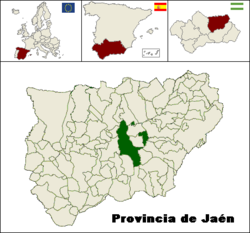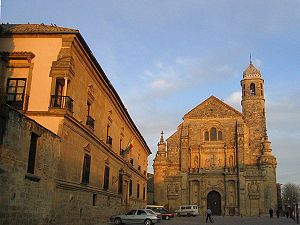Úbeda, Jaén
| Úbeda | |||
|---|---|---|---|
| Municipality | |||
 |
|||
|
|||
 |
|||
| Location in Spain | |||
| Coordinates: 38°0′50.84″N 3°22′20.81″W / 38.0141222°N 3.3724472°W | |||
| Country |
|
||
| Autonomous community |
|
||
| Province | Jaén | ||
| Comarca | La Loma de Úbeda | ||
| Judicial district | Úbeda | ||
| Government | |||
| • Mayor | Antonia Olivares Martínez (PSOE) | ||
| Area | |||
| • Total | 397.1 km2 (153.3 sq mi) | ||
| Elevation | 748 m (2,454 ft) | ||
| Population (2010) | |||
| • Total | 36.025 | ||
| • Density | 0.091/km2 (0.23/sq mi) | ||
| Demonym(s) | Ubetenses | ||
| Time zone | CET (UTC+1) | ||
| • Summer (DST) | CEST (UTC+2) | ||
| Postal code | 23400 | ||
| Official language(s) | Spanish | ||
| Website | Official website | ||

El Salvador Chapel and Dean Ortega's Palace
|
|
| UNESCO World Heritage Site | |
|---|---|
| Official name | Renaissance Monumental Ensembles of Úbeda and Baeza |
| Location |
Jaén Province, Spain |
| Coordinates | 38°00′42″N 3°22′18″W / 38.0117°N 3.3717°W |
| Area | 397.1 km2 (4.274×109 sq ft) |
| Criteria | Cultural: ii, iv |
| Reference | 522 |
| Inscription | 2003 (27th Session) |
| Website | www |
|
[]
|
|
Úbeda (Spanish pronunciation: [ˈuβeða]; from Arabic Ubbada al-`Arab and this from Iberian Ibiut) is a town in the province of Jaén in Spain's autonomous community of Andalusia, with some 36,025 inhabitants. Both this city and the neighbouring city of Baeza benefited from extensive patronage in the early 16th century resulting in the construction of a series of Renaissance style palaces and churches, which have been preserved ever since. In 2003, UNESCO declared the historic cores and monuments of these two towns a World Heritage Site.
Recent archaeological findings indicate a pre-Roman settlement at Úbeda, such as argaric and iberic remains. The capital of the iberic state was called Iltiraka and was located over the Guadalquivir river, 10 km south of the actual site of the town. Romans and later Visigoths occupied the site as a settlement. This area became an important city in the Muslim conquest of the Iberia. It was refounded by Abd ar-Rahman II (822–852), who called it Arab's Ubbada i.e. ´sأُبَّدَة الْعَرَب (Ubbadat-Al-Arab). It was included in the area of Jaén. In this period, its territory extended to more than 35,000 hectares.
During the Reconquista, in 1233, King Ferdinand III was able to wrest the town from the Muslim rulers. After that, the Muslim, Christian and Jewish cultures coexisted for a long time.
...
Wikipedia




